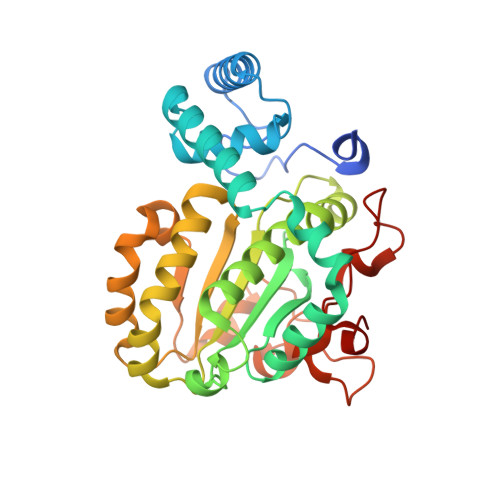Functional anatomy of phospholipid binding and regulation of phosphoinositide homeostasis by proteins of the sec14 superfamily
Schaaf, G., Ortlund, E.A., Tyeryar, K.R., Mousley, C.J., Ile, K.E., Garrett, T.A., Ren, J., Woolls, M.J., Raetz, C.R., Redinbo, M.R., Bankaitis, V.A.(2008) Mol Cell 29: 191-206
- PubMed: 18243114
- DOI: https://doi.org/10.1016/j.molcel.2007.11.026
- Primary Citation of Related Structures:
3B74, 3B7N, 3B7Q, 3B7Z - PubMed Abstract:
Sec14, the major yeast phosphatidylinositol (PtdIns)/phosphatidylcholine (PtdCho) transfer protein, regulates essential interfaces between lipid metabolism and membrane trafficking from the trans-Golgi network (TGN). How Sec14 does so remains unclear. We report that Sec14 binds PtdIns and PtdCho at distinct (but overlapping) sites, and both PtdIns- and PtdCho-binding activities are essential Sec14 activities. We further show both activities must reside within the same molecule to reconstitute a functional Sec14 and for effective Sec14-mediated regulation of phosphoinositide homeostasis in vivo. This regulation is uncoupled from PtdIns-transfer activity and argues for an interfacial presentation mode for Sec14-mediated potentiation of PtdIns kinases. Such a regulatory role for Sec14 is a primary counter to action of the Kes1 sterol-binding protein that antagonizes PtdIns 4-OH kinase activity in vivo. Collectively, these findings outline functional mechanisms for the Sec14 superfamily and reveal additional layers of complexity for regulating phosphoinositide homeostasis in eukaryotes.
- Department of Cell and Developmental Biology, School of Medicine, Lineberger Comprehensive Cancer Center, University of North Carolina at Chapel Hill, Chapel Hill, NC 27599-7090, USA.
Organizational Affiliation:



















